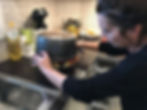August 2025
- dialasalci1997
- Aug 31
- 8 min read
Recreating ancient recipes.
I want to take you behind the scenes of how we’ve recreated 68 Mesopotamian recipes for Table of Gods—and also give you a chance to be a recipe tester for any of the three final recipes in the book.
Just send me an email at arim@tableofgods.com and let me know if you want to try a dessert, meat, or date wine recipe (or all three)—and I’ll get back to you with more information.
If you’ve already informed me about being a recipe tester, no need to send an email again :)
Now to the process.
Step 1: research
The first step in recreating ancient recipes is to do research. This is one of the reasons it has taken over 2,000 days to complete this book.
Over the years I’ve gathered so much information that I’ve built an internal Wikipedia-like web to search my notes and past resources. This includes research from over 300 books and papers.
But no matter how much research I do, it’s impossible to recreate any ancient dish that’s 100 percent authentic.
As Will Durant once wrote, “Our knowledge of the past is always incomplete.”
But that doesn’t mean we shouldn’t try to make sense of it, which I’m sure Durant would agree with.
When my mom helped me make the first recipes back in 2019-2020, I told her our recipes needed to fulfill three requirements. They had to:
1. Taste good
2. Be authentic
3. Be practical
I’ve since removed the first point. Taste buds are too complex to have a universal definition of “tasting good.”
And just because someone doesn’t like blood doesn’t mean I shouldn’t use it (which I have) if it makes a recipe more authentic.
This leads to points two and three. Usually, the more authentic the recipe, the less practical it becomes.

Mom, cooking. I didn’t understand what unconditional love was until my mom offered unconditional help with whatever I asked for to make the recipes in the book.
Striking the right balance between authentic and practical has been one of the toughest challenges of creating this book.
Make a recipe too authentic and nobody will attempt to cook it. Make it too practical, or even wrong, by using ketchup, mayonnaise, or barbecue sauce, and the whole idea behind Table of Gods falls flat.
We’ve avoided ingredients that weren’t available in ancient Mesopotamia, like tomatoes, avocados, or corn.
We’ve also avoided processed foods and additives that didn’t exist, such as refined sugar and baking soda (which is why we consulted a food scientist for the cake recipes).
But sometimes we’ve prioritized convenience over authenticity. For example, we suggest using instant yeast instead of making a sourdough starter for the baking recipes and common wheat instead of emmer wheat (common wheat actually became more popular in Mesopotamia toward the end of the second millennium BC).
In general, I think it’s more important you make a recipe than not make it at all because you can’t find the authentic ingredients.
That’s why I suggest using chicken eggs instead of wild bird eggs, apples for crab apples, table salt for evaporated marsh salt, lemons for citrons, cow’s milk for buffalo milk, a stove for a clay oven—you get the point.

Speaking of wild bird eggs—after three years of searching, I finally got my hands on an ostrich egg (yes, it’s the size of my head). Follow me on Instagram, TikTok, or Facebook if you want to see what we make of it.
Step 2: concept
Imagine if someone asked you to make a cookbook based on European cuisine. You’d probably freeze. What does that even mean? Well, the same is true for ancient Mesopotamian cuisine.
Mesopotamia's diverse climate—the southern marshes, alluvial plains, and northern rain-fed zones—created varied conditions for agriculture and livestock.
The cultural differences between Sumerians, Akkadians, Assyrians, Amorites, and Babylonians contributed to distinct food cultures.
And the 3,000 years of history I’m covering makes it even more diverse, since trade with the Indus Valley, Africa, and later Spain evolved and brought new ingredients to ancient Mesopotamia (modern-day Iraq and neighboring countries).
That’s why I’ve decided to narrow the recipes in Table of Gods to specific places and time periods, which eventually became the eleven chapters (cuisines) of this book.
This made it much easier to decide what recipes go where.
For example, in the first city/chapter of the book, we’re in Eridu in 3566 BC. During that period, the Persian Gulf hadn’t receded yet and lay along the shores of Eridu.
This made it obvious that there should be a fish recipe in the Eridu chapter.
I started by researching what types of fish swam in the Persian Gulf 5,500 years ago.
I found out that among many species, tuna, sharks, and mackerel were caught.
Don’t ask me how they caught sharks, but shark bones have been found in human graves.
But since sharks are endangered, and tuna is extremely expensive, the most practical fish of these is the mackerel.
The Indian mackerel (Rastrelliger kanagurta) is common in the Persian Gulf and would have been easy to catch for the fishers living in Eridu 5,500 years ago.
Though not as globally traded as tuna, the Indian mackerel is easy to come by in Asia, East Africa, and Australia. The Atlantic mackerel is available in most other places in the world.
And since the two species are similar, it fulfills my authenticity requirements while also being practical.
And that’s what the research and conceptualization can look like for a recipe in Table of Gods.

In this photo, we used Atlantic mackerel because Indian mackerel wasn’t available in Sweden, where I’m based. The setting is supposed to resemble a sunset on the shores of Eridu in 3566 BC. The red spice is sumac.
Step 3: storytelling
I was never interested in just making a cookbook with recipes. It wasn’t intriguing enough and felt like every other cookbook out there.
So I decided early on that every recipe should have a short story about a god or goddess, king or queen, or in some cases my own experiences from three research trips to Mesopotamia.
I wanted every story to stand on its own and eventually connect to the recipe. This is another reason it has taken years to complete the book.
If I had a great story with no bridge to a recipe, I couldn’t include it. If I had a great recipe without a matching story, I couldn’t include it either.
For the fish recipe above, I retell the Sumerian myth about Fish and Bird.
Both fight over who’s more beautiful while insulting each other. Eventually, the god of wisdom, Ea, settles the dispute, judging (spoiler alert) in favor of Bird.
That’s why Fish ended up on the plate above :)
Step 4: testing
When I’m done researching and have conceptualized and decided what kind of story I want to tell and the recipe we should make, I bring in the recipe creators.
Fortunately for me, they happen to be my mom, dad, and sister. All with their special qualities in the kitchen. But since my dad has run restaurants for 30 years, he usually has the final say.
In the case of the fish recipe, I started by telling them we should make a recipe of mackerel, which was followed by hours of dialogue that went something like this:
Dad: How do you imagine the final dish? Is it a soup? Is it a whole cooked fish?
Arim: I don’t know, but not a soup.
Mom: Can you make a list of all the spices we can use?
Arim: No mom, it’s much easier if you just tell me what spices you want to use and I’ll tell you if it’s okay to use them (mom and I have had many fights over spices, haha).
Dad: We need acidity, salt, and fat. Can we use lemon?
Arim: No, lemons were probably not available in Eridu during this period. Can you use sumac instead?
Dad: That’s fine.
And so the discussion continues until we decide on spices, ingredients, and the cooking method.
We always make at least two versions to test different hypotheses, which is usually followed by one or two more tests.
When we’re dealing with desserts, we always run more tests. For example, the first time my sister made the baklava recipe, she baked three versions.
The second time, she made nine versions (inspired by the best variations from the first test), and now she’ll make nine more to decide on the winner, which is the one you’ll get to test if you choose to try a dessert recipe :)

On the left are mersu cookies from 1771 BC. On the right is an experiment of a milk-based dessert that didn’t make it into the book.
Step 5: editing
When we’ve completed all the tests and decided on a winner, my sister and parents jot down the ingredients, steps, and instructions as clearly as possible.

Sister and dad with dozens of recipe drafts. I’m not sure I would complete Table of Gods without their (and mom’s) help. Or maybe I would, but it wouldn’t include recipes, haha.
Then we send the recipes to a professional recipe editor. That’s someone whose only job is to edit recipes.
Despite our obsession with the recipe instructions, the editor always finds mistakes or improvements.
Often, these improvements are subtle. But I’m a strong believer in details, and convinced that many small details amount to something great in the end.
Step 6: recipe testers
When we’ve iterated on the best version of a recipe, and the recipe editor has gone through the instructions, we bring in recipe testers.
In the last round we had 140+ people cooking the recipes in the book 300+ times. This means that on average, every recipe was tested by at least two people (apart from our own tests).

Here are some photos from our recipe testers.
What’s great is that all recipe testers have different backgrounds but the same love for food and history.
It’s also great to get feedback from people in different parts of the world since not all ingredients are available everywhere.
One notable person who tested our Assyrian Bulgurotto recipe is Fredrik Eriksson—the gastronomic advisor to the Nobel banquet at Stockholm City Hall.
Not only did he cook the dish, but he served it to hundreds of guests at his restaurant in Nationalmuseum in Stockholm.
To my surprise, Fredrik didn’t change the recipe at all, which speaks to its quality.
Kudos to my dad, who created this recipe, which includes yogurt and fish sauce for extra tartness and umami.

Here I am with chef Eriksson who holds a plate of Iron Age Assyrian Bulgurotto.
Step 7: adjustments
The last step before finalizing a recipe is to gather all recipe testers’ feedback. This has led to many adjustments in the past.
So remember that as a recipe tester, you can actually have an impact on the final book!
A final reminder: if you’d like to test any of our last three recipes, send an email to arim@tableofgods.com and let me know your preference—dessert, meat, or wine.
Step 8: photoshoot
When the recipe is completed, it has to be photographed. We usually wait until we have 20-30 recipes ready before doing a photoshoot.
In September we’ll have our third and last photoshoot. I’ll post daily about it on my Instagram, so make sure to follow me if you’re curious.
Otherwise I’ll tell you all about it in the next progress update.

Some photos from our second photo shoot in January 2024. Our first photo shoot was in June 2021.
I hope you’ve enjoyed reading this month’s progress update.
If you have any questions or suggestions just write to arim@tableofgods.com and let me know.
I still read and reply to all emails—and will continue to do as long as it’s humanly possible!
Warm regards,
Arim